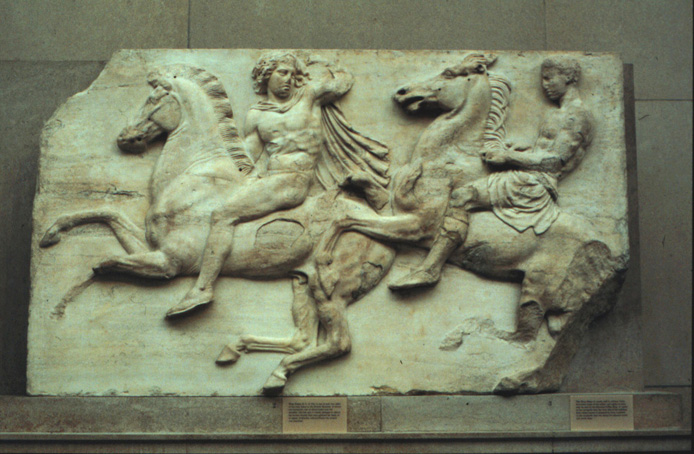Parthenon West Frieze: 2 horsemen
Copyright: Parthenon Frieze 2 West.jpeg
The Parthenon frieze was originally located within the pteroma at the top of the cella walls. It wrapped around the entire building and was 524 feet long. It is 3 feet, 3 inches high. Unlike the metopes, it is carved in very low relief, about 3 inches deep and slightly higher at the top for greater visibility. In its original situation, it was indirectly lit. But, it appears to have been carved in situ since the composition takes into account the columns of the peristyle. The frieze was carved entirely out of Pentelic marble. The grain runs horizontally. Like the other Parthenon sculptures, the frieze was originally painted and the background was bright blue ! Today about 420 feet of the frieze survives. About 60 percent of it was removed by Lord Elgin and is presently located in the British Museum in London. Most of the rest of the frieze is in the Akropolis Museum in Athens, however, parts can also be found today in Paris, Rome, Palermo, Vienna, and Heidelberg. The subject of the frieze is a procession that starts at the southwestern corner of the building and wraps around both sides, meeting in the center of the east frieze on the front of the building. Most scholars believe that the frieze represents the Panathenaic procession, however, the details of this identification are very controversial. The Panathenaia was the greatest festival of the year in Athens, an all – encompassing celebration of civic pride, that culminated on 28 Hekatombaion, Athena ‘s birthday. This was the day that the procession took place. The focal point of the procession was the presentation of a new robe (peplos) to the old Archaic cult statue of Athena that was housed in the Erechtheion. Only two slabs of the West Frieze were removed by Lord Elgin and the rest of the West Frieze remained in situ on the Parthenon until it was removed to the Akropolis Museum in the late twentieth century. The overall subject of the West Frieze is the preparation for the procession with figures lacing up shoes, getting attired, and mounting horses. The directional flow is from right to left (south to north) with some figures that turn back to the south in order to create a compositional unity with the South Frieze. Slab 2 is one of the most well – known, featuring two magnificent, heroically nude riders (probably carved by two different sculptors). The front rider has a three – quarters face and he looks back and raises his left hand to his head, a signal to the cavalcade behind him.

